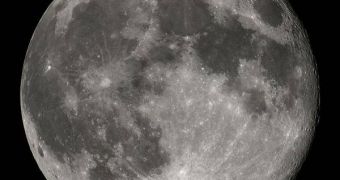The Interstellar Boundary Explorer (IBEX) spacecraft is the first probe sent to space whose mission is to accurately assess the boundary between our solar system and the surrounding outer space. Launched last October aboard a Pegasus-XL rocket, the craft has recently managed to discover a very peculiar phenomenon, close to our planet. It has found that the Moon is constantly emitting a stream of hydrogen, which researchers infer to most likely come from Sun-generated protons that hit the lunar surface.
The high-speed atoms hint at new ways of analyzing the lunar surface, and may even help astronomers develop new ways of gathering more details about the surfaces of other planets, moons and asteroids, close to Earth or far away. Because of its position and lack of magnetic shielding, the Moon is under a constant bombardment from radiation, most of which comes from the Sun. Solar winds generate streams of protons, which travel at about 1.6 million kilometers per hour, and then slam into the natural satellite. Most of these atoms remain trapped on the surface, but others keep on moving.
Astronomers suspect that, when some of the protons hit the Moon, they pick up electrons from its surface, and then bounce back to space as hydrogen atoms. When IBEX's high-speed particle detector was activated last December, the craft was just happening to pass by the Moon. All of a sudden, the team coordinating the spacecraft, which is based at the Southwest Research Institute (SwRI) in San Antonio, Texas, and led by Space Physicist David McComas, noticed that the instrument was receiving signals corresponding to streams of hydrogen atoms, which had until then only been theorized.
“We were still testing the instrument. We hadn't even gotten into full science mode,” McComas said. Writing in the latest issue of the journal Geophysical Research Letters, the team argues that as much as ten percent of all protons hitting the Moon form hydrogen and bounce back to space. However, these atoms are not electrically charged, which means that they are not influenced by the magnetic fields of the Sun or the Earth, ScienceNow reports.
Because they cannot be influenced, hydrogen atoms originating from protons can travel long distances, and astronomers could look for streams originating from locations such as Mars, Ceres, Vesta, and other such objects. In theory, the research could give them an idea of what type of surface reflected the protons, and it could also show them if the body is covered in dust, rocks, or even ice.

 14 DAY TRIAL //
14 DAY TRIAL //